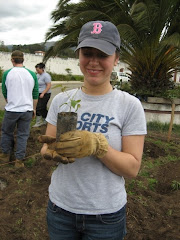I’m catching my breath after returning from a two week technical trip to the lowland and coastal regions of Ecuador. The diversity that exists in this country—among its people, plant life, cultures and climates, continues to amaze me. It was just a four hour trip from Cayambe to our training site in Puerto Quito, but it seemed like we had hopped on a plane and flown to another country. The entire drive was a steep, winding descent out of the Sierra, through the transitional zone and into the tropics. Just west of Quito, the green peaks of the páramo and eucalyptus-covered slopes of the Andes began to turn to smaller mountains and lush forests. The cool, dry mountain air mixed with the stifling coastal temperatures creating dense clouds that drenched the valleys and wrapped themselves around the hills. Driving through these tropical cloud forests of the transitional zone made me feel as though I was floating through a fairy land. The plant life was a mix of the gnarly, low-lying highland species and more tropical vines, ferns and seductive flowers. As we descended further, leaving the mountains behind us, the clouds finally dissolved and the road straightened itself out. The early evening sun was suddenly so strong that it stung my forearms and face through the windows of the bus. Our first night in Puerto Quito it was immediately apparent to us all that life on the Costa is totally different from what we are used to in Sierra. Instead of the peaceful sound Andean folk music, salsa and reggaetón blasted out of every open doorway; the beer was served ice-cold, not at room temperature; rather than being driven into bed early by the cold, people stayed up late talking and enjoying the somewhat cooler evening temperatures; we no longer heard the clear, sing-songy Spanish of the Sierra, with its excessive use of diminutives, but the rapid, muffled speech of the Costa. I loved it.
Our whole group of forty-three agriculture and natural resources volunteers spent the first week of field training together. We stayed at a field school belonging to the university and spent our days in classes, or visiting farms and current volunteers’ work sites to learn about their projects. The days were tough and long (lots of manual labor, dirt and sweat), but we thoroughly enjoyed our free time playing ecua-volley, ultimate frisbee, going for walks in the jungle, and swimming in the river and the pool. Our training covered everything from organizational development and conflict resolution, to killing chickens, castrating pigs and digging infiltration ditches. The second week of the trip, we were divided up depending on our area of work and the region that we will be going to. Eleven of us, all agriculture volunteers who will be living in coastal areas, were lucky enough to spend two incredible days in the Tsáchila community of El Poste, in Santo Domingo de Los Colorados. The Tsáchila are one of Ecuador’s many indigenous groups that still maintain their traditional customs, dress and language. Unlike much of the highland indigenous population, the Tsáchila managed to avoid being conquered by the Inca, therefore, they speak Tsáfiki rather than Quichua. Unfortunately, even in their remote communities the group’s numbers began to dwindle with the arrival of the Spanish and now their population is only about 2000. Our first day in El Poste, we learned about the Tsáchila language and culture. Nowadays, many men no longer dress in their traditional woven skirts and after a law barring nudity was passed by the province, the women wear tops. The practice of the men painting their hair with natural dye from the achiote plant for protection from evil and illness is also still very common. The Tsáchila are also very well-known for their shaman, or “curaderos”. The last night of our visit, our host, who is a shaman, performed a ceremony with us called a “limpieza” (cleansing). The entire ceremony was conducted in Tsáfiki, and involved a curious combination of Catholic practices and more traditional rituals with a variety of medicinal plants, music and chants. These ceremonies are used often to rid people of bad energy that makes them or those around them more vulnerable to illness, evil or misfortune. While in El Poste we also learned about the production and commercialization of cacao and other crops common to the coastal region, and we built a solar drier for cacao seeds.
We spent the rest of the week traveling to other areas of the hot, lowland region preparing for the work we will be doing in our sites. It was a nice break from rainy Cayambe and all of the classroom training we had been doing. We are now all excited to get out to our communities and begin work on April 19th.

No comments:
Post a Comment